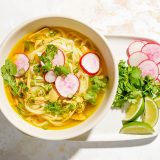Simply translated as chicken soup, Indonesia’s soto ayam seemingly is as basic as its name. Though the soup often is served with piles of garnishes, at heart it is a clean, clear and aromatic broth spooned over shredded meat and noodles or rice. We think of chicken soups as teeming with ingredients. Soto ayam flips that, using that multitude of ingredients to flavor the broth, then discards them.
Soto ayam is as much—if not more—about the broth as what the broth goes with. “Soto is not the kind of soup that you can put a stock cube into it,” says Sri Owen, the cookbook author largely responsible for introducing Indonesian cuisine to Western cooks. “There’s an art to making a proper soto.”
Cooks typically begin by simmering a whole chicken in water with aromatics. The best-known version, from the island of Java, relies on fresh turmeric for its brilliant color and earthy, balancing flavor. Lemon grass, makrut lime and black peppercorns also appear frequently.
Because the soup has so many variations (in fact, each of Indonesia’s numerous islands may have its own), few flavorings are considered essential besides garlic, shallot and ginger, which often are pounded into a curry paste flavored with coriander, cumin and whole peppercorns.
The paste is made with a mortar and pestle while the chicken simmers. It then is browned in a skillet in peanut oil. Once the chicken is cooked, it is removed from the broth—which is strained to remove any solids—then shredded. The cooked curry paste is added to the broth along with the shredded meat.
At Milk Street, we loved the way soto ayam keeps the focus on the bold flavors of the broth. But we did want to simplify. We found we could skip making the curry paste by browning whole ingredients—cilantro stems, scallion whites, chilies, peppercorns, lemon grass, ginger and garlic—then simmering them in the broth and straining them out.
And instead of a whole chicken, bone-in, skin-on leg quarters gently poach more quickly. Then the meat is shredded and returned to the broth, and both are ladled over noodles for a simple soto ayam nearly as flavorful as the original.




